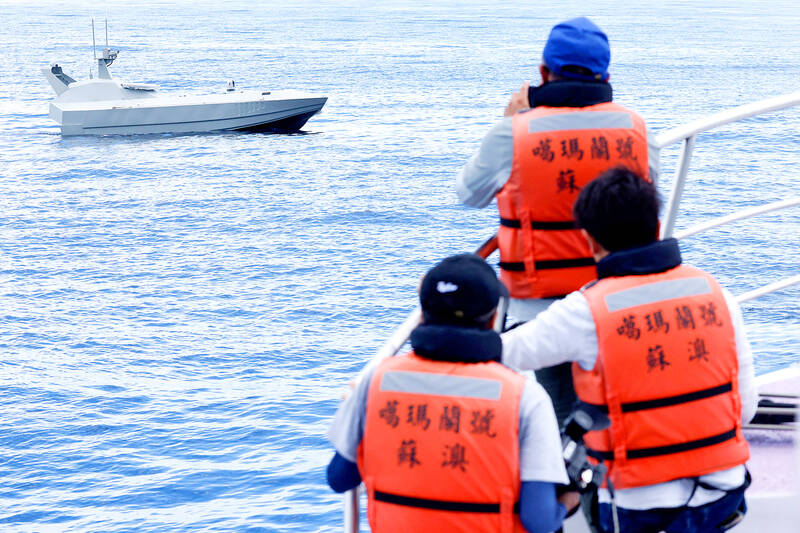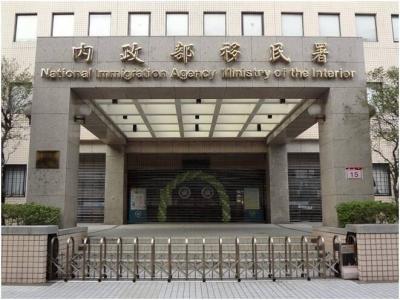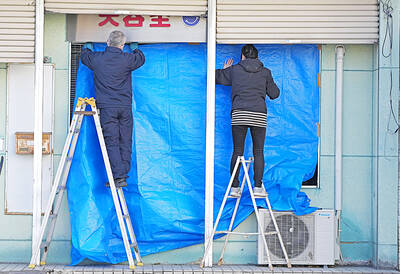Just off the small fishing port of Wushi (烏石) in Yilan County, a Taiwanese company is testing what could eventually be a powerful, but unglamorous new weapon in the nation’s military arsenal — sea drones.
Used to great effect by Ukraine in the Black Sea against Russia, Taiwan is learning lessons on how it could use sea drones as an effective and low-cost way to fend off any possible Chinese invasion.
These drones are uncrewed, remotely controlled small vessels that are packed with explosives and can be guided toward ships or potentially even attack targets in the air.

Photo: Ann Wang, Reuters
Pushed by the US, Taiwan has been working to transform its armed forces to be able to wage “asymmetric warfare” using mobile, smaller and often cheaper weapons that still pack a targeted punch, like sea drones.
“Uncrewed boats or vehicles have played a very significant role in the Ukraine war,” said Democratic Progressive Party (DPP) Legislator Chen Kuan-ting (陳冠廷), who sits on the Foreign Affairs and National Defense Committee.
“Uncrewed vehicles, whether they are boats or underwater vehicles, can effectively deter China because Taiwan is not the attacking side, we are the defending side,” he said.
Chungshan Institute of Science and Technology — the research and development arm of the Ministry of National Defense — has termed the sea drone plan the “Swift and Sudden” project, which has a modest budget of about NT$800 million (US$ 26.97 million).
Minister of National Defense Wellington Koo (顧立雄) on Wednesday said that sea drones would be included in an additional spending package to be unveiled later this year.
Details of that special budget have yet to be announced.
Thunder Tiger Corp chairman William Chen (陳冠如) told Reuters last week on a boat off Wushi while viewing a test of the company’s SeaShark 800 sea drone —which can carry 1,200kg of explosives and travel up to 500km — that these new weapons present an element of surprise for China.
“We can create uncertainty. We can fill the Taiwan Strait with danger and risks. No one knows where these dangers could surface,” Chen said.
Next week, Thunder Tiger is to join 11 Taiwanese and foreign companies in an exhibition just down the coast from Wushi arranged by the defense ministry to showcase uncrewed surface vehicles that might end up being added to Taiwan’s arsenal.
Other companies taking part include Taiwanese navy contractor Lungteh Shipbuilding and US military shipbuilder Huntington Ingalls Industries, the ministry said.
“Drones are a top priority for both the United States and Taiwan. Obviously the conflict in Ukraine is focusing minds on what the next generation of warfare will look like,” said US-Taiwan Business Council president Rupert Hammond-Chambers, who is leading a US defense industry delegation to Taiwan this week, including drone makers.
Since Russia invaded Ukraine in 2022, Taiwan has been studying how Kyiv has deployed drones to successfully offset Russia’s advantage on the battlefield and has enlisted commercial drone companies, including Thunder Tiger, to help.
Ukraine has deployed sea drones not only to attack ships in Russia’s Black Sea fleet, but also to shoot down aircraft.
Taiwan’s navy is dwarfed by that of China with its aircraft carriers and ballistic missile submarines, although the country lacks recent combat experience.
China’s last successful large-scale amphibious assault was in 1950, when it seized Hainan Island at the tail end of the Chinese Civil War, with troops ferried across on junks.
Peter Chen (陳柏宏), a drone expert and executive director of Taiwan security think tank Taiwan Military and Police Tactics Research and Development Association, said that Taiwan could undoubtedly make world-class sea drones.
“But when it comes to the application, how to turn them into top-notch weapons, it is not the responsibility of private companies. The views of government and the military on how to properly integrate the weapons into the battle strategy, that needs more thinking,” he said.

A small number of Taiwanese this year lost their citizenship rights after traveling in China and obtaining a one-time Chinese passport to cross the border into Russia, a source said today. The people signed up through Chinese travel agencies for tours of neighboring Russia with companies claiming they could obtain Russian visas and fast-track border clearance, the source said on condition of anonymity. The travelers were actually issued one-time-use Chinese passports, they said. Taiwanese are prohibited from holding a Chinese passport or household registration. If found to have a Chinese ID, they may lose their resident status under Article 9-1

Taiwanese were praised for their composure after a video filmed by Taiwanese tourists capturing the moment a magnitude 7.5 earthquake struck Japan’s Aomori Prefecture went viral on social media. The video shows a hotel room shaking violently amid Monday’s quake, with objects falling to the ground. Two Taiwanese began filming with their mobile phones, while two others held the sides of a TV to prevent it from falling. When the shaking stopped, the pair calmly took down the TV and laid it flat on a tatami mat, the video shows. The video also captured the group talking about the safety of their companions bathing

PROBLEMATIC APP: Citing more than 1,000 fraud cases, the government is taking the app down for a year, but opposition voices are calling it censorship Chinese Nationalist Party (KMT) Chairwoman Cheng Li-wun (鄭麗文) yesterday decried a government plan to suspend access to Chinese social media platform Xiaohongshu (小紅書) for one year as censorship, while the Presidential Office backed the plan. The Ministry of the Interior on Thursday cited security risks and accusations that the Instagram-like app, known as Rednote in English, had figured in more than 1,700 fraud cases since last year. The company, which has about 3 million users in Taiwan, has not yet responded to requests for comment. “Many people online are already asking ‘How to climb over the firewall to access Xiaohongshu,’” Cheng posted on

A classified Pentagon-produced, multiyear assessment — the Overmatch brief — highlighted unreported Chinese capabilities to destroy US military assets and identified US supply chain choke points, painting a disturbing picture of waning US military might, a New York Times editorial published on Monday said. US Secretary of Defense Pete Hegseth’s comments in November last year that “we lose every time” in Pentagon-conducted war games pitting the US against China further highlighted the uncertainty about the US’ capability to intervene in the event of a Chinese invasion of Taiwan. “It shows the Pentagon’s overreliance on expensive, vulnerable weapons as adversaries field cheap, technologically